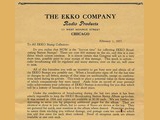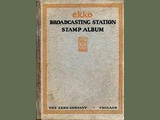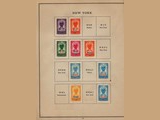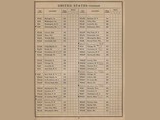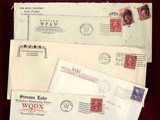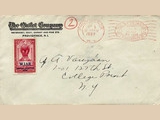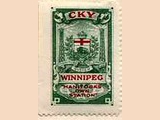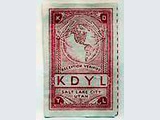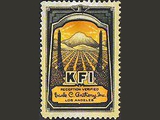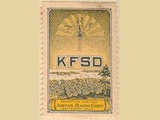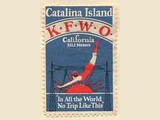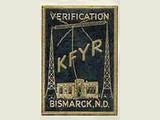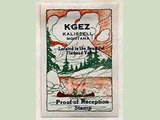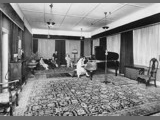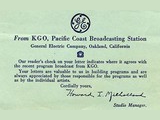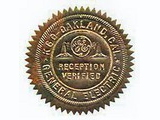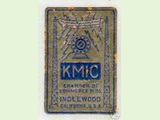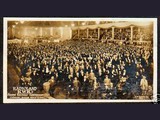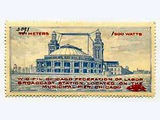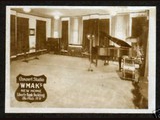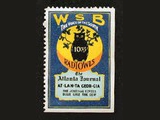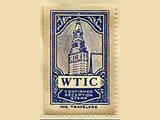Die Geschichte der QSL-Marken von EKKO und BRYANT
Seite in Bearbeitung
"The new radio stamp fad"
©Copyright 2006 C. M. Zelbst. Mit freundlicher Genehmigung des Autors

![]() (Picture: Radio News, February 1925) - With the end of World War I the world awakened to many new technologies, including commercial radio broadcasts, a mysterious and exciting entertainment that quickly captured everyone's imagination and interest! In the United States an advertising gimmick became a national craze, and for a brief period collecting RADIO VERIFICATION STAMPS rivaled postage stamp collecting! The EKKO Company of Chicago, IL developed the advertising concept of radio verification stamps as a means of exploiting this new technology that had captured the interest and passion of America. Their idea was to sell to the emerging radio broadcasting industry a marketing tool to help promote public interest in specific radio stations. The EKKO Company contracted with THE AMERICAN BANK NOTE COMPANY to design, and produce to order, stamps of the same high quality as current postage printings, to be used by commercial broadcasters in promoting their stations and radio shows to the listening public. The genius of this concept, intentional or not, was the combining of a popular hobby, stamp collecting, with the new and exciting pastime of listening to radio broadcasts from far away!
(Picture: Radio News, February 1925) - With the end of World War I the world awakened to many new technologies, including commercial radio broadcasts, a mysterious and exciting entertainment that quickly captured everyone's imagination and interest! In the United States an advertising gimmick became a national craze, and for a brief period collecting RADIO VERIFICATION STAMPS rivaled postage stamp collecting! The EKKO Company of Chicago, IL developed the advertising concept of radio verification stamps as a means of exploiting this new technology that had captured the interest and passion of America. Their idea was to sell to the emerging radio broadcasting industry a marketing tool to help promote public interest in specific radio stations. The EKKO Company contracted with THE AMERICAN BANK NOTE COMPANY to design, and produce to order, stamps of the same high quality as current postage printings, to be used by commercial broadcasters in promoting their stations and radio shows to the listening public. The genius of this concept, intentional or not, was the combining of a popular hobby, stamp collecting, with the new and exciting pastime of listening to radio broadcasts from far away!
_thumb.jpg)
![]() For reasons unknown, the second sequence was the printing of the words "verified reception stamp" directly below the station bar, and when the EKKO Company sold stamps to a broadcasting station, then the third printing sequence, the adding of the station call letters, was completed. This also allowed the call letters and the vrs wording to be printed in the same color. The primary colors for the American stamps are Red; Grey; Blue; Green; Orange; Gold, Purple and Brown and there were 16 secondary colors which were shades of the primary colors, for example, there is a light blue, a medium blue and a dark blue. The primary colors for the call letters and VRS wording were Black; Dark Blue; Red; and while rare, Green. For the Canadian Beaver design, the colors were more a pastel variety, with basically the same primary colors as the American version but with no secondary shades. The Canadian call letters and VRS wording were almost always printed in Black; Red or Dark Blue.
For reasons unknown, the second sequence was the printing of the words "verified reception stamp" directly below the station bar, and when the EKKO Company sold stamps to a broadcasting station, then the third printing sequence, the adding of the station call letters, was completed. This also allowed the call letters and the vrs wording to be printed in the same color. The primary colors for the American stamps are Red; Grey; Blue; Green; Orange; Gold, Purple and Brown and there were 16 secondary colors which were shades of the primary colors, for example, there is a light blue, a medium blue and a dark blue. The primary colors for the call letters and VRS wording were Black; Dark Blue; Red; and while rare, Green. For the Canadian Beaver design, the colors were more a pastel variety, with basically the same primary colors as the American version but with no secondary shades. The Canadian call letters and VRS wording were almost always printed in Black; Red or Dark Blue.
The sequential printing process was suppose to result in a finished product equal to that of postage stamps but because of plating alignment problems, it is quite rare to find an example where the station call letters and vrs are centered correctly to the stamp body, and such premium examples are highly sought after by today's collector. In addition, and considered to be error's, there are examples where the Call Letters are centered correctly and the vrs letters are not, and vice versa. These errors generally carry a premium in today's market.
With the onslaught of the Great Depression, 10 cents was no longer quite so insignificant to the collector, and the EKKO Company, like so many others, faded away. The American Bank Note Company disposed of its remaining EKKO stamp stock, and so this fascinating chapter of Cinderella collecting ended. . . or did it? Well, not quite, as an unknown quantity of stock apparently did survive and found its way into the market, where it was sold to radio stations which then typed their call letters into the station bar.
This created an interesting dilemma for collectors, many of which considered these unfinished stamps to be counterfeits. Today, such examples are categorized into two classifications, the first of which being those that have sequenced through the second printing process and have the wording "verified reception stamp" along with manually-typed in station call letters, are considered to be authentic and sell for premiums. The second classification, where the words "verified reception stamp" has not been printed are considered counterfeits, with the majority having been "produced" into the 1950's to meet the demands of the few active collectors of the time. Surprisingly, in the last five years, demand for these examples has increased enough to affect general market prices and today most often bring the same premium, if not more, as a completed EKKO! Station KGHI above is an example of a "counterfeit" EKKO and Station KARK is an example of an authentic second sequenced EKKO. There is also pictured an example of a non-EKKO verified reception stamp for Station KMIC that is printed on foil, and not to be considered in any manner as a slight, error or counterfeit, but simply because of formatting restrictions, the last stamp is for Canadian Station CKGW.
While remaining more of a curiosity than anything else for over 50 years, beginning most noticeably in the 1980's, collector interest began to re-awaken concerning these beautiful and interesting stamps, and collecting radio verification stamps has seen a steady increase in popularity. Stamp values have increased from literally nothing to prices for the rarer examples that now reach into the hundreds of dollars! As EKKO stamps are still readily available for the most part, this niche collectible provides the specialized collector with the opportunity to complete the collection for a relatively modest investment, and while EKKO stamps dominate the specialty, non-EKKO verification stamps sell for significant premiums and will most likely enjoy the greatest appreciation in value in the coming years. EKKO stamps for Canada and Cuba are especially sought after, as are a number of the American "super" stations. EKKO stamps for Hawaii and Alaska are considered extremely desirable and sought after as they were issued while these two American states were actually territories.
 For only $1.75, the Ekko Company offered an album to the collector of new stamps. The album contains pages preprinted with an outline of each of the stamps currently available, a listing of broadcast station call letters and wavelengths, and a nice map on the inside cover showing the locations of these stations. Spaces were also left for stations not yet participating, or stations that were just coming on the air. In addition, there was space to jot down up to four dial settings at your own time of reception.
For only $1.75, the Ekko Company offered an album to the collector of new stamps. The album contains pages preprinted with an outline of each of the stamps currently available, a listing of broadcast station call letters and wavelengths, and a nice map on the inside cover showing the locations of these stations. Spaces were also left for stations not yet participating, or stations that were just coming on the air. In addition, there was space to jot down up to four dial settings at your own time of reception.
"Proof of Reception" cards were furnished with the album. Listeners needed only to send a few facts on these cards about when and where on the dial they had heard a broadcast, plus ten cents to cover mailing costs, to the station. There the card was checked against the station log for accuracy, and the listener was mailed a stamp with the station's call letters and design upon it.
BRYANT-Stamps
Sortierreihenfolge: Rufzeichen
Bryant war eine von mehreren Firmen, die versuchte, aus dem neuen Boom Geschäft zu schlagen. Angeboten wurden vereinzelt auch Marken für Stationen außerhalb der USA und Kanadas. Die Rufzeichen wurden stets eingedruckt, das Design blieb unverändert: Die Weltkugel zwischen zwei Antennenmasten.
Manche Stationen gingen eigene Wege
Nicht alle Stationen ließen sich vereinnahmen - vom Zuspruch der Hörer wollten sie dennoch profitieren.
QSL-Stamp-QSL
Adventist World Radio
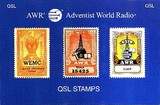
![]() Im November 2000 bestätigte AWR (Adventist World Radio) Empfangsberichte mit einer QSL-Karte, die drei Aufkleber zeigte:
Im November 2000 bestätigte AWR (Adventist World Radio) Empfangsberichte mit einer QSL-Karte, die drei Aufkleber zeigte:
- Den "Verification Stamp" von WEMC, den ersten Sender der Adventisten, im College von Berrien Springs, Mich - der heutigen Andrews University
- den Aufkleber, mit dem AWR 1977 Berichte für AWR Ekkala, Sri Lanka, bestätigte,
- den Aufkleber, mit dem AWR 1996 Berichte für KSDA, Guam, bestätigte.
Gedenkmünze
2016: 25 Jahre öffentlich-rechtlicher Rundfunk in Andorra
![]() Am 01. Juni 2017 wurde eine Spezialmünze mit einer Auflage von
Am 01. Juni 2017 wurde eine Spezialmünze mit einer Auflage von
85.000 Umlaufmünzen ausgegeben. Mit der Gedenkmünze wird das 25-jährige Jubiläum der öffentlich-rechtlichen Rundfunkanstalt Andorras und damit der Beginn der Ausstrahlung des andorranischen öffentlichen Radios und Fernsehens begangen. Das Münzmotiv zeigt ein Mikrofon und eine Antenne, sowie den Schriftzug „25è ANIVERSARI DE RÀDIO I TELEVISIÓ D’ANDORRA“, das Ausgabejahr „2016“ und den Ausgabestaat „ANDORRA“.
Quelle: ![]() ext. Link [05.07.2018]
ext. Link [05.07.2018]
